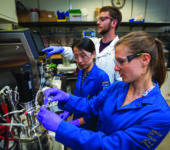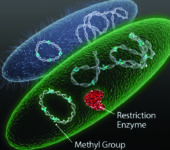Biosystems Design
-

Biodesign Scientists in Laboratory Study Agar Plates
Crosscutting and Multiscale Approach. Biodesign lies at the core of the Genomic Science Program’s three primary research focus areas: Bioenergy, Environmental Microbiome, and Biosystems Design. Here, Nurgul Kaplan (left) and Garima Goyal examine microbial colonies on agar plates in front of an automated microbial transformation-plating and colony-picking robot. The two scientists work in the Robots Room on DNA construction and robotics at the Agile BioFoundry.
-

Bioproducts with Engineered Fungi
Joint Bioenergy Institute researchers work in the laboratory on the biological production of indigoidine by Rhodosporidium toruloides.
-

Genetic Engineering in Microbes
A new method uses Escherichia coli to generate DNA with methylation patterns that targeted microbes recognize and accept as their own, facilitating customization of microbes for biofuels production.
-

Plant Scientists in Laboratory
Crosscutting and Multiscale Approach. Biodesign lies at the core of the Genomic Science Program’s three primary research focus areas: Bioenergy, Environmental Microbiome, and Biosystems Design. Plant scientists tend to tobacco plants, an important research tool for transient genetic transformation and protein expression. Pictured are Jillian Curran and her mentor Chien-Yuan “Kevin” Lin from the Biotech Partners Student Interns at Emery Station East.